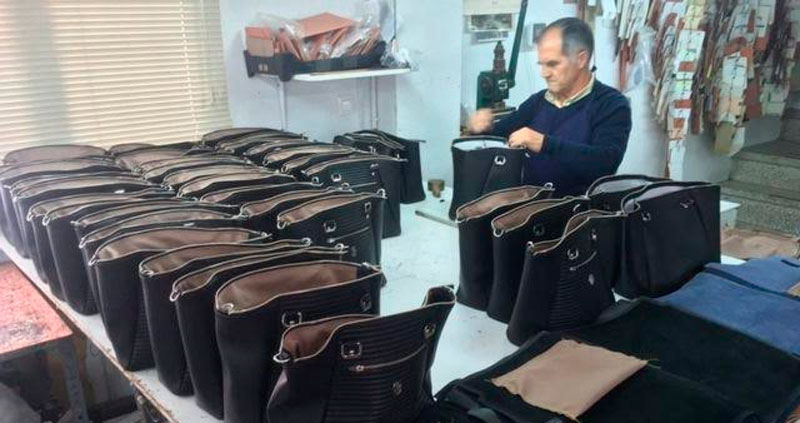Five Biological Engineering students from the National University of Colombia (UNAL), La Paz Headquarters, become pioneers for the production of a bio-leather, or natural leather, in order to replace animal leather, traditionally used in the textile industry.
The new product is made from coffee grounds or cunchos, which becomes raw material, together with cassava starch, for the leather used to manufacture belt waistbands, uppers for sandals, and bags.
The proposal seeks to meet the excessive need to obtain animal leather, which leaves a significant ecological footprint due to its pollutants, in addition to the fact that it uses large amounts of water for its preparation.

“We all know leather as a strong, durable, and versatile material, but have we ever stopped to think about the process needed to turn animal skin into shoes, bags, or other leather items?” says physical engineer Jaime Pérez Taborda, teacher and Academic Director of the UNAL Headquarters in La Paz.
He adds that, “although leather manufacturing has a tradition of more than 7,000 years, in its current form it is an unsustainable practice due to its high environmental costs in the tanning process, that is, transforming the skin of a dead animal into leather.” ”.
Although most people believe that leather is a byproduct of the meat industry, according to the United Nations Industrial Development Organization, 99% of leather comes from animals raised for meat or dairy production.
When talking about the environmental impact of leather, one cannot ignore the effects that intensive livestock farming generates on the planet: deforestation, excessive use and unequal land tenure, as well as water consumption and greenhouse gas emissions that add to the global warming.
Researchers from the National Taipei University of Technology (China) point out in a study – the results of which were published this year – that the carbon footprint of bovine leather ranges between 65 and 150 kg of CO2 per square meter. Considering that more than 2 billion m2 of leather are produced each year, this is a huge environmental liability.
In this scenario, biotextiles are a viable proposal as a substitute material for leather, especially if it is considered with a biodegradable and circular economy approach.
“The idea is to replace animal leather with this 100% biodegradable material. However, the development of bioleather prototypes is still undergoing studies and research”, explains Daneila Guevara Pimienta, one of the creators of this project.
The Biological Engineering students thought of something that was natural, with organic material of plant origin and that was aesthetically pleasing to the eye, and also commercial. As a first sample, they made a small bag decorated with crocheted details, to confirm that it was useful.
The natural leather they used is made up of: 84% cassava starch (which acts as a binder, gum or compactor), 11% coffee grounds, 4.99% glycerin and 0.01% calcium chloride.

SUSTAINABLE OPPORTUNITY
With more than 1.5 million head of cattle, Cesar is recognized in Colombia as one of the main cattle herds in the country.
 “Thinking about biotextile ventures in the region allows us to take advantage of this opportunity to add value to the leather sector, offering socially and environmentally responsible products to the international market.”
“Thinking about biotextile ventures in the region allows us to take advantage of this opportunity to add value to the leather sector, offering socially and environmentally responsible products to the international market.”
“In addition, since coffee and cassava are grown in Cesar, we saw that it was easy to have these elements for this project, which has been the opportunity to implement what was learned in the Heat Transfer and Movement Operations class,” indicates the Guevara student.
For his part, Lorens Melissa Castilla Calderón, also a member of the group, asserts that “we want to offer a product that has good mechanical resistance and is at low prices.”
In addition to the students Guevara and Castilla, Dariens Isaac Pérez Díaz, Sara Elena Vizcaíno Corrales and Yeimi Hernández participated in the project, who mention that it is possible to use this material for belt waistbands, uppers for sandals and bags.
PROJECTIONS
 Professor Pérez mentions that “these projects within the classroom reflect how we went from the conventional classroom and the demonstration laboratory to the extended territorial learning classroom-laboratory, in which the creation, innovation, appropriation and transfer of knowledge contribute to the productive transition of the region”.
Professor Pérez mentions that “these projects within the classroom reflect how we went from the conventional classroom and the demonstration laboratory to the extended territorial learning classroom-laboratory, in which the creation, innovation, appropriation and transfer of knowledge contribute to the productive transition of the region”.
The bioleather prototype has inspired new ideas, including using the material as a seed-containing matrix in the form of single-use containers or degradable bioplastics that contribute to the restoration process of the tropical dry forest, or reinforcing the bioleather with natural fibers of fruits from the region such as corozo and mango from hilacha and fique.


